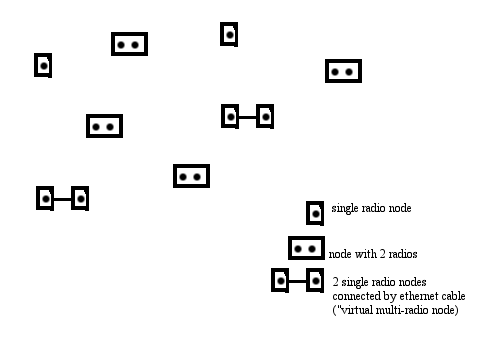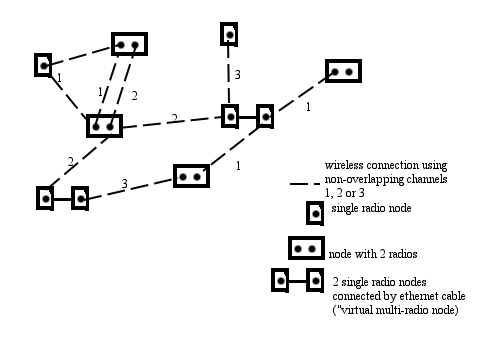D-07S-05: Difference between revisions
Jump to navigation
Jump to search
Nachtigall (talk | contribs) No edit summary |
Nachtigall (talk | contribs) (structurized) |
||
| Line 1: | Line 1: | ||
= About = |
|||
| ⚫ | |||
| ⚫ | |||
Assigned to: Jens Nachtigall |
Assigned to: Jens Nachtigall |
||
| Line 5: | Line 8: | ||
Expected Submission: December 2007 |
Expected Submission: December 2007 |
||
= Motivation (Aufhänger) = |
|||
= Problem Statement = |
|||
= Related work = |
|||
== Other solutions/approaches and their weaknesses (and strengths) == |
|||
== Similar solutions/approaches and there weaknesses == |
|||
= My solution/approach (WiP) = |
|||
== Assumptions == |
|||
== Challenge == |
|||
== Ideas (brainstorming) == |
|||
== Deliverables == |
|||
== Project excecution plan == |
|||
=== Done so far === |
|||
=== What's next (TODO) === |
|||
==Problem Statement== |
==Problem Statement== |
||
Revision as of 08:50, 29 June 2007
About
Working title: Using wireless mesh networks for Early Warning Systems
Assigned to: Jens Nachtigall
Advisor: Kai Köhne
Expected Submission: December 2007
Motivation (Aufhänger)
Problem Statement
Related work
Other solutions/approaches and their weaknesses (and strengths)
Similar solutions/approaches and there weaknesses
My solution/approach (WiP)
Assumptions
Challenge
Ideas (brainstorming)
Deliverables
Project excecution plan
Done so far
What's next (TODO)
Problem Statement
- Early Warning Systems needs real-time communication (the reactive source routing protocols cannot achieve this)
- using cheap COTS hardware (no or very limited access to the MAC layer, but it is fine to switch channels every x secs)
- 802.11b offers 3 non-overlapping channels, 802.11a even 12 (usually these are not utilisised, but the mesh is on one channel or manually partioned into several channel collision domains). Make possible several simultanous transmission in a neighbourhood, by splitting the collision domain
- make use of these multiple channels by means of ("virtual") multiradio nodes like the WRAPBoards without excluding the common single radio nodes, i.e. utilise multiple radios (channels) whenever possible whithout requiring a node to have several radios
Further possible enhancements (just ideas)
- use ETX (or?) for channel quality measures (consider other nodes not from our mesh in ISM band)
- node admin might be allowed to set some of his radios to a fixed channel
Deliverables
- Distributed channel assignment algorithm
- based on a proactive routing protocol (allows world view)
- using unmodified standard 801.11 MAC (only interacting with the MAC by switching the channel of one the available interfaces from time to time)
- increase throughput (to retrieve data, e.g. MiniSeed) and decrease latency (for EWS) by using non-overlapping channels, i.e. a node can receive and transmit at the same time by setting its two wifi interfaces to non-overlapping channels
Prior Art
- several attempts to make use of the non-overlapping channels by proposing a different MAC layer (however, for COTS you usually do not have access to the MAC):
- Dissertation A Proactive Routing Protocol for Multi-Channel Wireless Ad-hoc Networks by Unghee Lee (requires two radios at every node; one is used for control/routing information only and the other one for data/ack only). It says:
- 3.2.5.2 Independent Access [to several channels without reserving one channel/radio for control information]
- A more complex control scheme for channel negotiation can allow simultaneous access to different channels by using multiple transceivers. This can increase the channel utilization. Although this scheme seems to be more practical and profitable, practical aspect and feasibility need to be examined in detail [28].
- and
- As discussed in Section 3.2.5, even though independent access seems to be practical and beneficial, this is beyond our current scope and remains a topic for future research.
That's what I would like to do :-)
- previous work has a lot of constrains: does not consider other network, requires MAC, requires always several radios (how about channel assignment for just one radio?)
Key Ideas / Project Execution Plan
- proactive protocols have a "world view" of the network. This is nice because routes to nodes do not have to be found out on demand prior to sending data (which is slow) (the routing protocol could also not only flood link state information but also other information every node with a certain hop distance (adjustable by TTL) should know like GPS coordinates of all nodes
- the idea is to piggyback channel assignment information with the HELLO or TOPOLOGY CONTROL (TC) messages of http://olsr.org and to have a distributed channel assign algorithm taking into account joining/leaving/movement of nodes
- switching channels can be done every x secs using libiw/iwconfig/wl
- both radios are used for data and control (routing) messages, no need to reserve one radio for control messages only
- 2 (or more) single radio nodes that are connected by an ethernet cable can form a "virtual multi-radio node"
- diff. cha. assignements can lead to different network topologies.
An image says more then 1000 words
Project Log
- getting an overview / reading papers
TODO
- what kind of distributed channel assignment algorithms exist
- how do these work in case we have a world view (proactive protocol)

